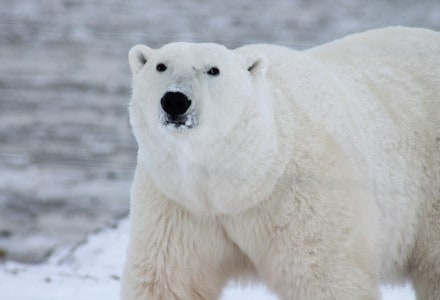
Polar Bear Facts
- Firstly, growing to roughly the same size as the Kodiak, the magnificent Polar Bear represents one of the two largest species of bear on earth.
- It has also, rather understandably, evolved to fill a highly specific ecological niche, given the unique nature of its environment.
- Also, aside from the native Inuits who have long coexisted with this incredible animal, it was first described by explorers in 1774.
- Particularly appropriately, its distinctive scientific name, Ursus maritimus, in Latin, means maritime bear.
- Its primary threats include climate change and its related habitat loss. Consequently, the IUCN has classified this animal as Vulnerable.
Related Species
Polar Bear Physical Description
While the gorgeous Polar Bear remains an especially overall, it does display a rather marked degree of sexual dimorphism.
As a result, a males also attain a weight of as much as 1,543 lb (700 kg), while the much smaller female only reaches about half of that.
In addition, the larger males reach a length of nearly 10 ft (3.05 m), while females do not quite reach 8 ft (2.44 m).
The extremely long and rather thick coat appears primarily white, though it tends to yellow slightly as the individual ages.
- Kingdom: Animalia
- Phylum: Chordata
- Class: Mammalia
- Order: Carnivora
- Family: Ursidae
- Genus: Ursus
- Species: U. maritimus
Polar Bear Distribution, Habitat, and Ecology
Firstly, the native range of the truly impressive Polar Bear primarily lies within the Arctic Circle and its surrounding areas.
Though it occurs rather rarely, individuals sometimes appear as far south as Newfoundland, in Canada, in North America.
This animal is technically classified as marine mammal, since it often spends months at sea, on floating ice.
Meanwhile, the beautiful Polar Bear also actually ranks as the most carnivorous member of the bear family.
Though it remains an opportunistic hunter, its prey primarily consists of ringed seals and bearded seals.
Species Sharing Its Range
Check out our other articles on Bee Hummingbird, Tuatara, 10 Dazzling Denizens of the Depths, Sea Spider, Giant Leopard Moth, Yellow-Eyed Penguin

